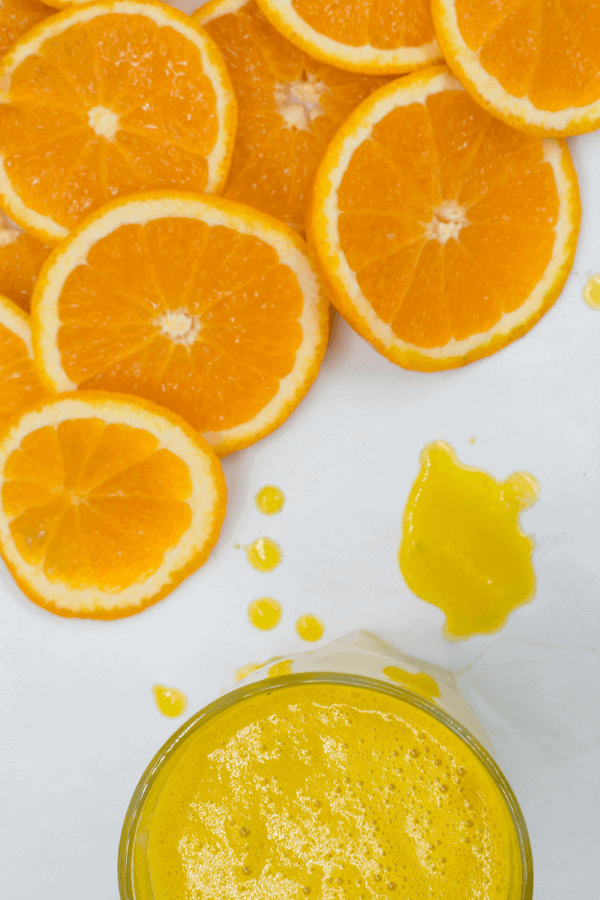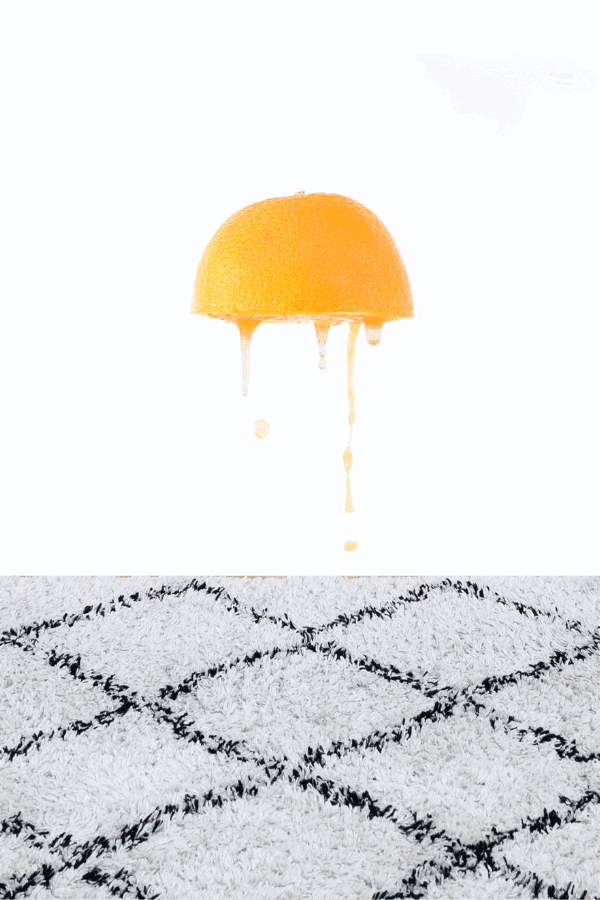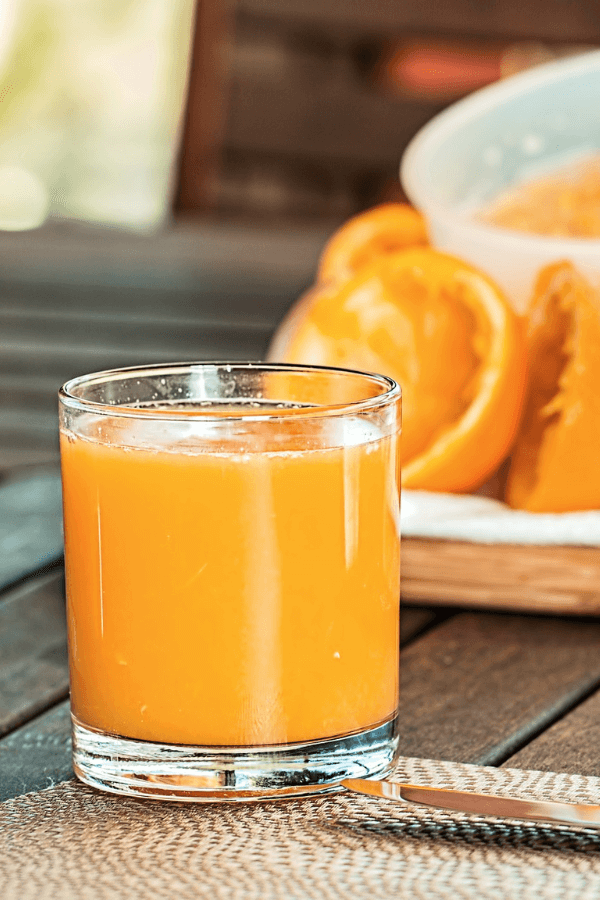Learn how to tackle those nasty orange juice stains on our carpets at home. Orange juice is a quintessential stable of most homes. It is considered the preferred drink for children worldwide and a refreshing, nutrient-rich treat on a hot summer’s day.
However, with such intense popularity comes another common association, a stubborn staining agent. This is particularly frustrating when it comes to carpet staining, which cannot simply be thrown into a washing machine for a hot cycle.
Therefore, it is vital that we are all aware of the best techniques for tackling these nasty carpet stains for good. Read on to find out about the best methods to remove orange juice stains from your carpet at home.
As an Amazon Associate, I earn from qualifying purchases. The links below may be affiliate links. Please read my disclosure policy for more information.

Why are Orange Juice Stains So Tough
Fruit juice is usually on the top ten worst stains list, not long after coffee and red wine. But, unfortunately, these decepticly sweet and innocent drinks have the making of a perfect staining agent for your carpet.
Firstly, their bright colors play an essential role. For example, the distinctive bright orange color results from a high concentration of a compound called carotenoids.
The juice is so rich in this compound that even a small spill will allow them to penetrate deeply and engrain itself into the fibers of your carpet. Essentially, orange juice is primed to latch onto any material and glare its distinctive orange hue to remind you of your mistake.
Moreover, orange juice is rich in citrus acid. Citrus acid is a crucial component of orange juice, providing it with the distinctive taste we all love.
Unfortunately, citrus acid can be a reasonable power substance. However, it can act as a bleaching agent, particularly when it is also exposed to sunlight. If you are unfortunate enough to have created this perfect storm, you will have guaranteed it permanently stained your carpet.
The staining properties are not restricted to fresh orange juice. Its concentrated alternative may actually contain dyes and food coloring.
Ultimately, orange juice is primed to produce a stubborn and unsightly stain. Therefore, it is imperative that you act fast and apply the correct cleaning method to deliver the best results.
What to Do Before you Clean
Like any stain, it is critical to follow some initial steps to prepare it for removal. This will give you the best opportunity to remove the stain more easily on the first attempt.
As soon as you spill juice on your carpet, you must act immediately. Firstly remove as much of the liquid as possible. This is true when you spill an entire glass or just a few drops.
Carpets are installed with several layers, so you must get a clean damp towel and compress it into the carpet. This will dilute the juice and agitate it before it penetrates and dries.
Blot the damp area with a clean, dry towel to pick up as many juice particles as possible. You may have already prevented the juice from staining if you are fortunate.
Once you have completed these steps, you should allow the area to dry to access the affected areas that you will have to treat. As always, acting quickly and decisively gives you the best chance of removing the stain.
When you are using purposely designed chemicals, always follow the manufacturer’s instructions to avoid any other disasters. When using DIY techniques, you should follow the instructions below but always trust your instincts too.

Method 1 – Baking Soda
One of the quintessential and potent home-based cleaning compounds is baking soda. It is a classic technique for a reason, it packs a mighty punch and is excellent at not damaging the surface it is supposed to clean.
Baking soda is a mild alkali with a PH of 8. This makes it an excellent method for tackling citrus acid stains, as it acts as a neutralizing agent.
The most effective cleaning technique is adding around a cup of baking soda to half a cup of water. You are attempting to make a paste that has a similar consistency to toothpaste.
Apply the paste generously to the affected areas and allow at least a few hours for it to fully dry to a crust. Make sure the room is aerated, and use heat to speed up the process if you are in a hurry.
The purpose of baking soda is to reduce the bond between the juice particles and the carpet fibers. Next, vacuum the dried residue and blot it with warm water to take up any remaining particles.
Assess the stained area. If the stain has not been entirely removed, try this method one more time. It is a delicate method that is less potent than some other techniques. Therefore, doing it twice may be necessary to have the desired effect.
Method 2 – Enzyme Wash
A less common but highly effective stain-cleaning compound is an enzyme wash. Most often, they are used for removing pet urine stains from delicate textiles, making them highly potent cleaning agents.
Most often, you can pick up enzyme washes in your local pet store, which are relatively inexpensive. They tend to come in a premixed liquid or in powder for you to mix with water at home.
Apply them to the stained areas, and be sure to scrub them into the fiber reasonably rigorously. Generally, you must allow around 2 hours for it to take effect, but always follow the manufacturer’s recommendations.
Once finished, you can use cold water and a clean cloth to blot and remove the treated areas. Allow it to air dry for a few hours and inspect the results. If this has not worked, you will have to move on to more specialized cleaning methods, as it is considered a powerful cleaner.
Method 3 – White Vinegar
White vinegar is another highly effective classic DIY method for tackling even the most stubborn of household stains. Luckily you probably have an ancient bottle at the back of your kitchen cupboard, so you should be ready to take on the stain immediately.
First, mix ¾ cup warm water with ¼ cup white vinegar. Ideally, you would then use a spray bottle to apply to the affected areas.
Apply generously to the stained area and allow it to cure for around 3 hours. Once completed, you should use cold water and a towel to remove the juice from the stained area.
You can try to cover the stain with a towel, put heavy objects on it, and leave it for around 15 minutes. This is a great technique to achieve more remarkable results, but do not leave the weight on too long as it can help the juice spread further and penetrate deeper over time.
It is essential that you remove all of the remaining vinegar as it will eventually cause a stain itself if left on your carpet.
Method 4 – Laundry Detergent
Laundry detergent has been refined over the years to be incredibly effective at eliminating tough stains while being gentle on our clothes. Therefore, it is an excellent substance for most other textiles too.
Mix a cap of laundry detergent with two cups of hot water and mix it thoroughly. If you wish to enhance this method, add ½ a cup of vinegar too.
Again, apply generously with a cloth and allow around 30 minutes for the chemicals to take affect. Then, use cold clean water and a towel to blot the area to remove the detergent now bound with the juice particles.
Laundry detergent is purposefully designed to lift stains, so you should see some fantastic results. Just be mindful not to let any residual detergent remain on the carpet, as it will become harder to remove over time.

Conclusion
Tackling any stain is a frustrating and arduous process. However, when you are equipped with the best method for the job, you will guarantee that you will save time and a headache.
Of course, acidic orange juice stains on your favorite carpet will always be a nuisance. But following the methods outlined above will hopefully put your panicked mind at ease.
Fortunately, three of the four techniques deliberately utilize substances that you probably already have at home. Therefore, you should easily be able to handle these stains and get back on with your day.



